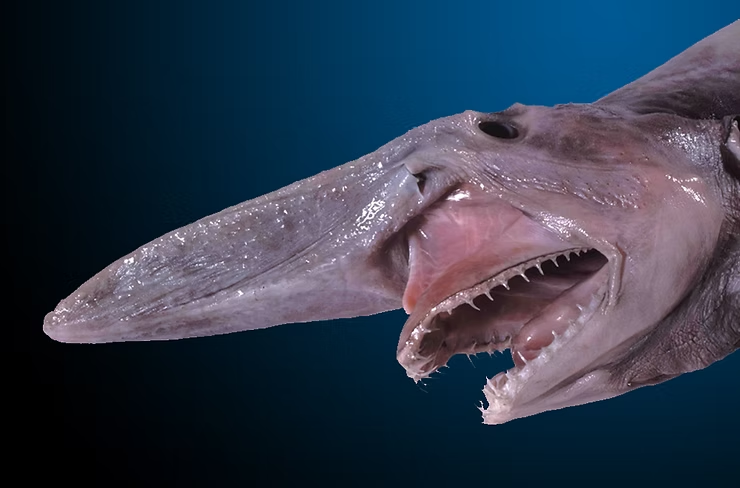The Enigmatic Goblin Shark
The goblin shark is one of the ocean’s most unusual predators, combining myth, mystery, and science. With its distinct appearance and rare sightings, this deep-sea species continues to intrigue both researchers and storytellers.
The Mysterious Origins
Legends of the Okeanides
Mythology often links goblin sharks to the Okeanides, mystical guardians of the ocean’s treasures. Their eerie look and elusive nature have inspired tales of ancient lineage and divine protectors of the deep.
Temple Guardians
Ancient lore also portrays goblin sharks as guardians of submerged temples, their bizarre features amplifying the aura of secrecy. Legends suggest they safeguarded marine sanctuaries, adding mystique to their reputation.
Genetic Roots
Beyond legend, science points to evolutionary adaptations. Genetic mutations shaped their elongated snouts, pinkish skin, and remarkable jaws, enabling them to thrive in extreme environments for millions of years.
Distinct Features
Forehead Spike
- A cartilaginous extension believed to house electroreceptors.
- Aids in detecting prey in deep waters.
- May assist in hydrodynamic movement.
Unique Teeth
- Front teeth are long and needle-like for gripping slippery fish.
- Back teeth are flatter and used for crushing prey.
- A dual-function design ideal for varied diets.
Extended Tail
The elongated tail contributes to their slow but strategic hunting style, helping them maneuver in the depths with bursts of speed when striking prey.
Habitat and Range
Primary Locations
Goblin sharks are frequently found in the deep marine waters near Japan, especially along continental slopes and submarine canyons. Their distribution also extends to the Atlantic and Pacific, though sightings remain rare.
Preferred Environments
They inhabit steep underwater slopes, trenches, and seamounts—areas with little human activity but abundant deep-sea prey.
Feeding Behavior
Slingshot Feeding
Perhaps their most famous trait is the slingshot jaw. In a fraction of a second, the jaw projects outward to snatch prey before retracting, a startling yet efficient hunting strategy.
Diet and Hunting
- Prey includes squid, crustaceans, and deep-sea fish.
- They scavenge opportunistically when possible.
- Patience and stealth allow them to ambush with precision.
Evolutionary Connections
Goblin sharks belong to the order Lamniformes, making them distant relatives of sand sharks and thresher sharks. Their lineage traces back over 125 million years, marking them as living fossils of the ocean.
Conservation Challenges
Population Concerns
Due to their deep-sea habitat, population data is scarce. Limited sightings hinder conservation assessments, but concerns include low reproduction rates and vulnerability to bycatch.
Human Impact
- Overfishing reduces available prey.
- Deep-sea trawling disrupts habitats and leads to accidental captures.
- Pollution, including plastics, poses threats to their environment.
Protective Measures
Marine sanctuaries, stricter fishing regulations, and ongoing research aim to safeguard these sharks. Raising awareness about their role in deep-sea ecosystems is crucial for long-term protection.
Conclusion
The goblin shark is a rare blend of myth and biology, showcasing both evolutionary resilience and cultural fascination. From its legendary origins to its unique feeding strategies, this species remains a symbol of the mysteries still hidden in the ocean’s depths. Protecting it ensures the survival of one of nature’s most extraordinary marvels.

